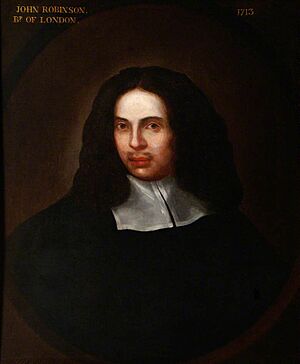John Robinson (bishop of London) facts for kids
Quick facts for kids The Right Reverend and Right Honourable John Robinson |
|
|---|---|
| Bishop of London | |
 |
|
| Church | Church of England |
| Diocese | Diocese of London |
| Elected | c. 1714 |
| Reign ended | 1723 (death) |
| Predecessor | Henry Compton |
| Successor | Edmund Gibson |
| Other posts | Bishop of Bristol 1710–1774 |
| Orders | |
| Consecration | c. 1714 |
| Personal details | |
| Born | 7 November 1650 Cleasby, North Yorkshire |
| Died | 11 April 1723 (aged 72) Hampstead, London |
| Buried | All Saints Church, Fulham |
| Nationality | English |
| Denomination | Anglican |
| Parents | John Robinson (d. 1651) |
| Occupation | Diplomat |
| Alma mater | Brasenose College, Oxford |
John Robinson (born November 7, 1650 – died April 11, 1723) was an English diplomat and an important church leader. He became the Bishop of London, a very high position in the Church of England. He took over this role from Henry Compton.
Contents
Early Life and Education
John Robinson was born in Cleasby, North Yorkshire, a small place near Darlington. His father, also named John Robinson, was a cooper (someone who makes barrels).
John went to Brasenose College, Oxford, a famous university. After that, he became a fellow at Oriel College. Around 1680, he started working as a chaplain (a priest for an organization) at the British embassy in Stockholm, Sweden.
He stayed in Sweden for almost 30 years! During this time, he often acted as Britain's main representative, even when the official minister was away. This meant he was doing important diplomatic work when events in northern Europe were very exciting. One cool adventure he had was traveling to Narva with King Charles XII of Sweden in 1700.
His Important Career Roles
In 1709, John Robinson came back to England. He was given several important church jobs. He became the Dean of Windsor and Wolverhampton. In 1710, he was chosen to be the bishop of Bristol. He also held the position of Dean of the Chapel Royal.
In August 1711, he took on a special government job called Lord Privy Seal. This was very unusual because it was the last time a bishop was asked to fill such a high political role. His coat of arms even had a motto written in runic characters, showing his connection to Scandinavia.
Signing the Treaty of Utrecht
In 1712, Bishop Robinson represented Great Britain at a very important meeting called the Congress of Utrecht. He was the main representative for Britain. In April 1713, he signed the treaty of Utrecht. This treaty was very significant because it officially ended the War of the Spanish Succession.
Soon after he returned to England, he was chosen to be the Bishop of London. He took over from Henry Compton in this role.
Idea for Church Union
In 1718, Bishop Robinson supported an idea to bring the English and Swedish churches closer together. The Swedish Ambassador in London, Count Gyllenberg, also liked this plan. However, most Swedish bishops did not agree with the idea. They felt the Church of England was too different from their own beliefs. So, the plan did not happen.
Later Life and Family
John Robinson passed away in Hampstead, London. He was buried at All Saints Church, Fulham. He was very generous to Oriel College, giving them a lot of help and money.
He was married twice but did not have any children. His first wife was Mary Langton. His second wife was Emma Cornwallis. Emma lived many years longer than him, passing away in 1748.
His Writings
John Robinson wrote a book called Account of Sweden together with an Extract of the History of that Kingdom. It was published in London in 1695. The book was also translated into French. Some of his letters can still be found in the British Museum.
Family Connections
John Robinson had an older brother named Christopher Robinson. Christopher moved to the Virginia Colony in America. He became the head of one of Virginia's most important early families.

